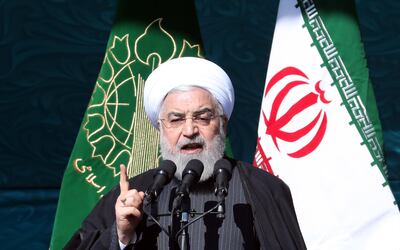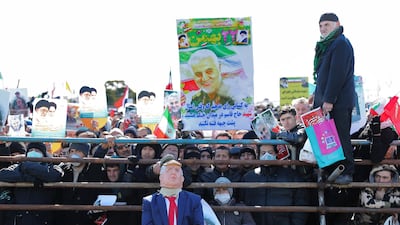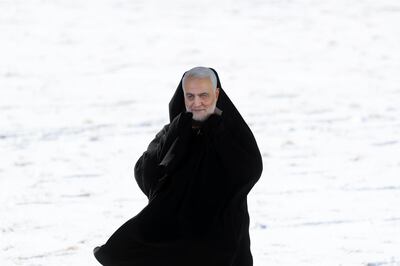A US-Iran deal is on the horizon and negotiations could begin as early as this year, a former US diplomat and intelligence officer said.
In a vindication of the Trump administration’s maximum pressure strategy, David Gordon, now a senior adviser at the International Institute for Strategic Studies, said it was no longer a question of if Tehran returns to the negotiating table but when.
"Iran has to enter into negotiations," Mr Gordon told The National. "There's no way they can last five years".
Sanctions imposed by Washington after US President Donald Trump pulled out of an Obama-era deal limiting Tehran’s nuclear programme have hit the country hard.
Oil revenues have plunged, and high rates of inflation and a youth unemployment rate of 28.6 per cent have hit the spending power and financial security of the Iranian people.
In London, Mr Gordon said Mr Trump’s strong position heading into the presidential elections in November this year was one of the main reasons that a deal soon was more likely.
“If the Iranians perceive the election is not going to be competitive, there could be an opening to start negotiations as early as 2020,” he said.
Mr Trump's campaign has been buoyed by a strong US economy, dashing Iranian hopes for a more favourable negotiating partner.
The economy grew 2.3 per cent in 2019, and his campaign has seized on a low unemployment rate, about 3.6 per cent, as evidence that he has made good on his promise to "Make America great again".
Mr Trump has also gained from infighting among a crowded field of opposition candidates, with former vice president Joe Biden failing to get clear of his rivals in the race for the Democratic nomination.
Mr Gordon said killing Iran’s top military commander, Qassem Suleimani, in a US drone strike in Baghdad in January was a key factor in bringing Tehran to the negotiating table.
Taking out the head of the Islamic Revolutionary Guard Corps' foreign operations arm, the Quds Force, makes the prospect of a new deal much more likely.
“Suleimani was the key operational figure in Iran’s regional policy,” Mr Gordon said.
He said the general was a “leading voice” of Iran’s sceptical approach to US engagement before and during negotiations for the 2015 deal.
Although the IRGC was likely to intensify its antagonistic strategy towards the US in the region, Suleimani's absence will seriously limit Iran’s capabilities, Mr Gordon said.
“They’ve lost such a strategic figure.”
Mr Gordon said the US stance to minimise fallout from Iran’s retaliatory missile strikes on American bases in Iraq was laying the groundwork for a deal.
“President Trump gave the impression that the Asad [airbase in Iraq] attack was de-escalatory,” he said.
Straight after the attack it was suggested that Iran had deliberately missed its target to avoid US casualties.
“The picture presented by the US media and the Trump administration isn’t really accurate,” Mr Gordon said.
Other analysts have stressed the accuracy of Iran’s missile strikes.
Dara Massicot, a military analyst at the Rand Corporation, said in January that satellite imagery showed the strikes appeared to have been aimed at the base’s capability.
“When I see the impact points of Iran’s strike on Asad airbase, I don’t see purely symbolic strikes designed to avoid casualties, as some have speculated,” she said on Twitter.
On Tuesday the Pentagon said more than 100 US soldiers had been diagnosed with traumatic brain injuries from the attacks.
Reimposing crippling sanctions has increased tension dramatically and has set Washington and Tehran on a path of brinkmanship.
But last month, Mr Trump said: “The US is ready to embrace peace with all who seek it.”
But Tehran on Tuesday taunted the US as it marked the 41st anniversary of the ousting of the American-backed shah, Reza Pahlavi.

"In the past two years, America has put so much pressure on our beloved people, on all of our trade, all of our exports, all of our imports, and all of the country's needs, to exhaust the patience of our people," President Hassan Rouhani told a rally in the capital.
But "the Americans did not understand the greatness of the Iranian people".
"It is unbearable for the United States to accept the victory of a great nation and that a superpower has been driven out of this land."
Mr Gordon said that a future deal between Washington and Tehran would most likely involve a “meaningful extension” of the timeframe from the existing nuclear agreement, which was due to run until 2030.
Any deal would also cover the issue of Iran’s ballistic missile programme, including possible restrictions on shorter-range missiles such as those used to strike at US forces in Iraq last month.
But the most difficult part of a future deal, Mr Gordon said, would be a way to put “a floor under regional tensions” and monitor them.



